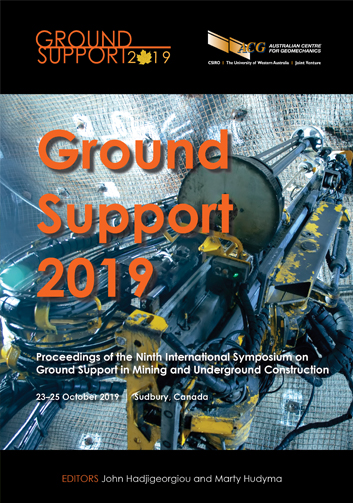Explicit discrete fracture network numerical analyses of the stability of underground stopes and effects of cable bolt support at Raglan Mine

|
Authors: Lavoie, T; Andrieux, P; Guido, S; Caumartin, R |
DOI https://doi.org/10.36487/ACG_rep/1925_22_Andrieux
Cite As:
Lavoie, T, Andrieux, P, Guido, S & Caumartin, R 2019, 'Explicit discrete fracture network numerical analyses of the stability of underground stopes and effects of cable bolt support at Raglan Mine', in J Hadjigeorgiou & M Hudyma (eds), Ground Support 2019: Proceedings of the Ninth International Symposium on Ground Support in Mining and Underground Construction, Australian Centre for Geomechanics, Perth, pp. 327-340, https://doi.org/10.36487/ACG_rep/1925_22_Andrieux
Abstract:
Within the frame of the 2018 feasibility study of the Raglan Mine Mining Project 14 in northern Quebec, stability analyses of longhole stopes and the effects of cablebolting were conducted in the form of advanced three-dimensional discrete fracture network (DFN) simulations. DFN analyses examine, in an explicit manner, the potential for strata to loosen and unravel, and wedges to form and fall along various excavation surfaces due to local joint sets. A DFN model is a randomly generated explicit representation of a unique set of discrete fractures whose geometrical characteristics—in terms of orientation, spacing and persistence—honour the statistical description of the joint sets present in the local rock mass. The kinematic stability of that unique situation is then examined in a direct manner with the 3D discontinuum-based 3DEC numerical code. Since each DFN model, or ‘realisation’, is randomly generated and unique, multiple realisations are required to derive statistical confidence in the outcome. This paper describes the DFN methodology, discusses two means of populating a realisation (through the joint sets statistics or by ‘bootstrapping’ the characterisation data), introduces the velocity-based stability criterion retained for the analyses, and presents and compares results, with and without tendon ground support.
Keywords: numerical modelling, discrete fracture network, support design
References:
Ghani Rafek, A & Goh, T 2012, ‘Correlation of joint roughness coefficient (JRC) and peak friction angles of discontinuities of Malaysian schists’, Earth Science Research, 10.5539/ESR, vol. 1, no. 1, pp. 57–63.
Itasca 2017, 3DEC Version 5.20 Theory and Background, Itasca Consulting Group, Inc., Minneapolis.
Palmström, A 1996, ‘The weighted joint density method leads to improved characterization of jointing’, Proceedings of the Conference on Recent Advances in Tunnelling Technology, pp. 1–6.
Rocscience 2015, DIPS Version 6 User’s Manual, Rocscience, Inc., Toronto.
© Copyright 2026, Australian Centre for Geomechanics (ACG), The University of Western Australia. All rights reserved.
View copyright/legal information
Please direct any queries or error reports to repository-acg@uwa.edu.au
View copyright/legal information
Please direct any queries or error reports to repository-acg@uwa.edu.au